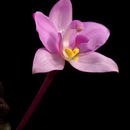fr
noms dans le fil d’Ariane


Bletia purpurea, like most other orchids native to Florida, came to the brink of extinction when, starting in the 1800s, settlers exploited the seemingly unbounded supply of tropical orchids, removing them in enormous quantities from their habitat as plants to sell in northern states.Urban development and agriculture in Florida subsequently claimed almost all remaining native orchid habitats.The combined result of this history is that a minute fraction of original population sizes of native orchids remain.Orchids are wind pollinated and most require extremely specific conditions for their dust-sized seeds to grow, including precise humidity, light, and connection with fungal symbionts.Although mature plants produce millions of seeds the probability of survival is tremendously slim and small populations cannot survive on their own.
The pine pink has been targeted by the “Million Orchid Program” at the Fairchild Tropical Botanical Garden as one of five orchid species to reintroduce into oak and mahogany host trees in urban Miami neighborhoods in an “unlimited quantity” to relieve these species from threat of extinction.The program aims to micropropagate thousands of individual orchids at a time in test tubes and recruit community volunteers and K-12 students to plant the seedlings in appropriate locations and follow their progress.The goal is to reestablish enough individuals throughout urban environments that the orchids will be able to reproduce on their own, be resilient to any collection they may be susceptible to, and along with associated education programs make these species and the plight of fragile native Florida habitats visible to city dwellers and visitors.The other orchid species in culture at Fairchild are: Encyclia tampensis, Cyrtopodium punctatum, Prosthechea boothiana, and Prosthechea cochleata.
A similar program through the Singapore Botanic Gardens has succeeded in restoration of native orchids in urban Singapore.
(Fairchild Tropical Botanic Garden 2013; Wing 2013)
The pine pink orchid, Bletia purpurea, also called the sharp-petaled bletia, is the most widespread of the approximately 35 species in genus Bletia.This orchid species is native to Florida, the West Indies, and from Mexico down to Peru.It grows at altitudes up to 2000 meters (Gann et al. 2014).A terrestrial orchid, it grows throughout a broad range of tropical and subtropical habitats including mesic pinelands and hammocks, on floating logs in inundated marshes and swamps, in highly disturbed areas, dry woods and fields, and humus over limestone.Though it does not tolerate salt water flooding, it grows near salt water at the base of cypress trees and stumps above the high tide line, especially where other vegetation protects it from salt spray.
The B. purpurea plant grows 30-60 cm (1-2 feet) in height, with 3-7 grass-like leaves and simple or branched inflorescence stalks that reach up to 150 cm (5 feet) tall.The showy pale pink-purple flowers (sometimes white in the Dominican Republic), about 1.25-3 cm (0.5-0.75 inches) wide, bloom mostly between December through May.In the West Indies bees pollinate the flowers but in Florida, where there are no pollinators present, they are self-pollinating (autogamous).They produce a green capsule-like fruit containing the tiny seeds.
Extreme morphological variation of this orchid prompted a recent study to examine quantitative and qualitative characters of Bletia purpurea from 63 populations across the range.This study revealed that the population in Acazonica, Mexico is distinct, and described it as new species B. riparia (Palestina and Sosa 2002).
Like most Florida native orchids, the population of B. purpurea in Florida is rare in the wild, threatened by habitat loss and collection and it is state protected. It is also listed on CITES Appendix II - Trade controlled to avoid use incompatible with species survival. It is recently a target of the “million orchid program” at the Fairchild Tropical Botanical Garden as one of five orchid species for copious laboratory micropropagation in an effort to re-establish the species into urban parts of its native distribution (a complement to other existing orchid reintroduction projects focused on natural areas).
(Ames and Correll 1953; Fairchild Tropical Botanic Garden 2013; Gann et al. 2005-14; Palestina and Sosa 2002; Sadler 2011; Wikipedia 2014)